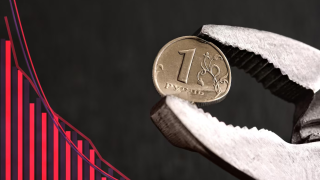In August 2023, the RUB to USD exchange rate increased to RUB 102, but after Russia's Central Bank raised the key interest rate from 8.5% to 12%, the exchange rate decreased to RUB 94. Despite this deliberate appreciation, the Ruble's current exchange rate is the lowest since the 1998 denomination, excluding March 2022. What's more significant is that the tighter monetary policy is not only slowing down the economic growth rate but also intensifying the risks of a prolonged recession in Russia.
Following February 24, 2022, in less than two weeks, the RUB exchange rate surged from 80 to 135. After the initial shock, the Ruble started to regain ground, and in June-July, the exchange rate dropped to 55, which meant the Ruble was stronger than the period before the onset of the conflict.
Both the record depreciation and the sharp rebound of the Ruble have underlying causes. Severe sanctions and pessimistic expectations adversely affected the currency. In response, the Central Bank of Russia substantially increased the key interest rate from 9.5% to 20%. A 30% commission was introduced for purchasing foreign currency in currency trades. Exporters were mandated to supply 80% of their foreign currency earnings to the market. Limits were imposed on taking more than USD 10,000 abroad, and a cap of USD 10,000 was set for deposit holders to withdraw money in foreign currency. Furthermore, due to sanctions, Russia's product imports dwindled, thereby reducing the outflow of foreign currency. Simultaneously, higher energy prices boosted Russia's export revenues by almost USD 100 billion, reaching USD 588 billion, according to the World Bank. These collective measures contributed to the Ruble's strengthening.
By January 1, 2023, the USD to RUB exchange rate stood at 73. The peak oil prices had already passed, compelling Russia to sell its oil at decreasingly lower prices. As of August 21, Russian Ural oil was priced at USD 70, and Brent at USD 85. In recent months, the disparity had been even wider, whereas before the conflict, the prices were nearly identical.
The cheaper oil led to reduced Russian export revenues, resulting in a diminished currency inflow. Concurrently, through parallel imports and other methods, Russia managed to somewhat recover its imports. The country had to pay more for products obtained via intermediary countries, leading to higher currency outflow. Moreover, Russia's Central Bank gradually eased its monetary policy. As a result, the USD to RUB exchange rate surpassed 80 in June, 90 in July, and 100 in August.
The current situation in the Russian economy is challenging to discern due to the country's statistical authorities no longer publishing certain statistics, and the reliability of the published data being in question.
Unlike other economic indicators, the exchange rate cannot be concealed. The exchange rate also holds political significance, often being considered positive when it appreciates and negative when it depreciates. However, at times, governments not only aim to prevent depreciation but even actively encourage it.
Sanctions notwithstanding, the Russian economy remains heavily reliant on energy carrier exports. These exports bring in foreign currency, while the RUB is the official currency of payment within the country. The national budget is denominated in RUB, and salaries, pensions, and other government payments are officially conducted in RUB. If, for instance, a civil servant's salary is RUB 100,000, with an exchange rate of 80, it would require USD 1,250 for payment. At an exchange rate of 100, USD 1,000 would be needed, and at 120, only USD 833. This principle extends to pensions, social benefits, and other state payments. In the January-July period of 2023, Russia faced a budget deficit of USD 29 billion, surpassing 80% of the annual plan. Consequently, a depreciation of the RUB against the USD serves, on one hand, to ease the meeting of budget obligations.
However, while RUB depreciation might make pension payments more manageable, there's always a price to pay. If the USD to RUB exchange rate were to reach 1,000, economic theories wouldn't be necessary for the population, living under authoritarian rule, to feel the effects in their pockets.
Yet, even though the Central Bank has limited means to artificially bolster the RUB, utilizing this approach incurs inevitable losses and isn't a cure-all solution.
Increased key interest rates make credit more expensive, impacting ordinary citizens and businesses seeking loans at high rates, deterring some from borrowing altogether. Reduced consumer credit leads to lower retail sales and diminished business loans result in fewer new enterprises and limited modernization of existing ones. Thus, reduced lending is closely tied to decreased economic activity, which in turn signifies a decline in citizens' living standards.
Apart from raising key interest rates, the Russian state and central bank possess other levers. One such approach is to dip into international reserves, though this is a temporary fix due to the finite nature of reserves. Prior to the Ukraine invasion, Russian reserves stood at USD 643 billion; as of 11 August 2023, they have shrunk to USD 586 billion, with USD 300 billion frozen by the United States—some of which might be considered for transfer to Ukraine.
If circumstances deteriorate, Russia might replicate its actions from last March. It could further increase key interest rates, restrict its citizens from withdrawing even minor amounts of USD from the country, close borders, and significantly curtail imports. However, beyond theoretical possibilities, the economic growth rate and the essential need for imported goods tip the scales. Moscow must choose between an artificially strong currency and a sluggish economy or adjusting exchange rates and contending with inflation.
Currencies fluctuate against others, sometimes subtly, sometimes necessitating issuance of 15-digit banknotes. Zimbabwe introduced a 100 trillion banknote in 2008. Since its inception (October 2, 1995), GEL has depreciated by 100%, from 1.30 to 2.61 against the USD. Concerning the RUB, after truncating three zeroes in January 1998, the USD value was 5.96 RUB; by September of that year, due to crisis, the rate exceeded 20.0. Before the August 2008 war, the USD was valued at 23 RUB, 35 before annexation of Crimea in 2014, and 80 before the invasion of Ukraine in 2022. In total, the Russian RUB has depreciated by 1477%, from 5.96 to 94 against the USD. The RUB has also lost ground against the GEL. Twenty-five years ago, RUB 1 equated to GEL 0.22 and today it is down to GEL 0.028. (The GEL-RUBLE exchange rate isn't directly set is derived from the USD-RUB and USD-GEL exchange rate.)
The war in Ukraine persists, with Russia's defense budget reaching an unprecedented high of USD 86 billion for the Russian Ministry of Defense. The prospects for lifting sanctions are still distant. While it's true that the sanctions did not yield the initially expected outcomes, resulting in a contraction of Russia's economy by only 2.1% instead of the projected 8% to 10%, the effects of the sanctions are nonetheless palpable. It's undeniable that Russia's economy is facing challenging times. Notably, a significant portion of the measured economic growth pertains to military production—a factor that holds little utility in the long term, often being rendered obsolete shortly after military use (such as shells, missiles, and other military equipment). Consequently, evaluating a country's wartime economy based solely on GDP growth rate is impractical; it necessitates an assessment of various elements that contribute to GDP growth.
The future trajectory of the Russian economy and the fate of the RUB currency hinge largely on how events unfold on the frontlines and how the global community chooses to engage with Russia in terms of cooperation.







